on ornament, textiles and baldachins depicted on the ceilings of buddhist cave temples in khartse valley, western tibet. form, function and meaning
urn:nbn:de:0009-23-27670
Abstract
Paintings of textiles and ornament on ceilings of early Western Himalaya Buddhist temples have an important role to play in the experience of sacred space and religious meaning. Roger Goepper (1993 [2] , 1995 [3] ) was one of the first Western scholars to point out the importance of textile depictions and ceiling decoration in the art of Alchi/ Ladakh (ca 1200). Various other researchers, focusing in particular on the Assembly Hall of Tabo/ Spiti, Himachal Pradesh (mid. 11th C), elucidated specific aspects of ceiling depictions as purely decorative elements, imitations of textile patterns (Wandl 1996) [4] or focused on the possible function of ornamental depictions as honorific covers as suggested for earlier ceiling paintings in Dunhuang by Whitfield & Farrer 1990 and Whitfield 1996 [5] . Giuseppe Tucci (1935) [6] was the first to interpret early Western Himalayan temple’s ceilings as symbolic representations of canopies, which was later adopted by Klimburg-Salter 1996 [7] , 1997 [8] , 2001 [9] for various distinctive types of ceilings in Afghanistan and Western Tibet. However, collating new data from examples of this genre of painting during different periods as a single corpus allows a fresh perspective on the genre of ceiling designs and gives insights into structural principles of this long and refined artistic expression as well as the interpretation of their meaning within the architectonic tradition of Western Tibet temples and their overall iconographic programmes.<1>
Various sites in the Khartse (mKhar rtse) Valley represent important, but hitherto almost unknown examples of the rich and complex artistic culture under Western Tibetan Buddhist patronage from the 10th century onward (Figs. 1-3).
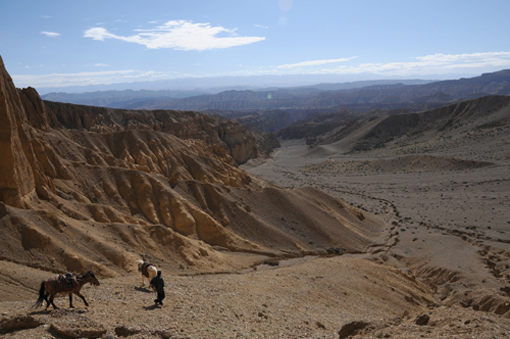
Fig. 1. Khartse Valley
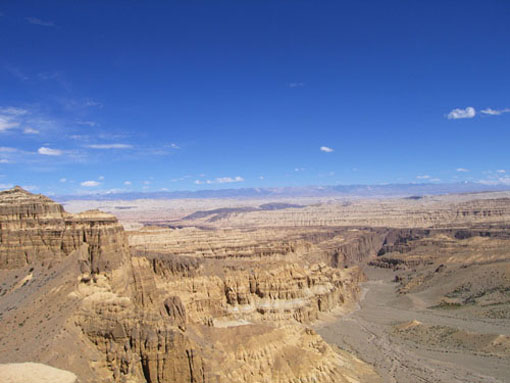
Fig. 2. View of Tsamda area from Khartse
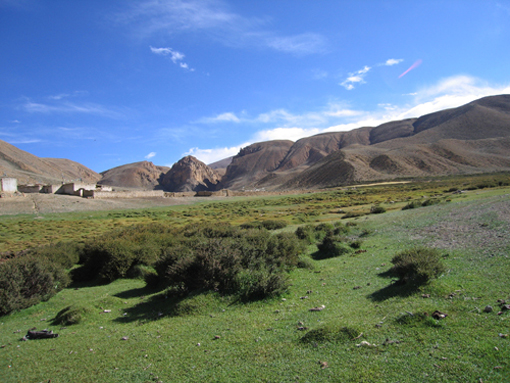
Fig. 3. Landscape around Khartse Village area
The Kardzong (mKhar rdzong) cave is one of the most interesting monuments among them (Fig. 4). The present article gives a first assessment of that site, exploring a little studied component of its decoration, namely ornamental depictions on the ceiling. Embedding them into the long and refined tradition of Indian and early western Tibetan ceiling designs the study attempts to analyze their form, function and meaning. This cave will be compared with a newly discovered sacred space in this valley, the »Tsülgye (Tshul skyes) Cave« [10] , which is exemplary for a later development of ceiling compositions and different symbolism of sacred space from the 15th /16th C onward, mimicking ephemeral sacred spaces on the model of Central Asian cave temples.
<2>
Khartse is known as the ancestral area of the »Great Translator« (lo chen) Rinchen Zangpo (958–1055) who played a vital role during the phase of the »Later Diffusion of Buddhism« (bstan pa phyi dar) initiated by the kings of Purang Guge in Western Tibet in the aftermath of the collapse of the Central Tibetan monarchy. [11] The area is located in the centre of Tsamda (rTswa mda) County (Maps 1-2), which lies in the southeast of Ngari (mNga’ ris) prefecture (Tibetan Autonomous Region, TAR). To the east one finds Tsaparang (rTsa rang), the former capital of the kings of Guge. [12] The area forms a long valley which is enclosed by steep cliffs. The Kardzong cave examined here is located in the high-altitude region (4,300 m) of the upper southern part of the valley (Map 2: VI). It is possibly the only sanctuary within a large complex of caves (ca. 30-40, each ca. 2x3 m in size) which were cut – at an elevation of approximately 200 m from the bottom of the valley – into south-facing cliffs (Fig. 4).
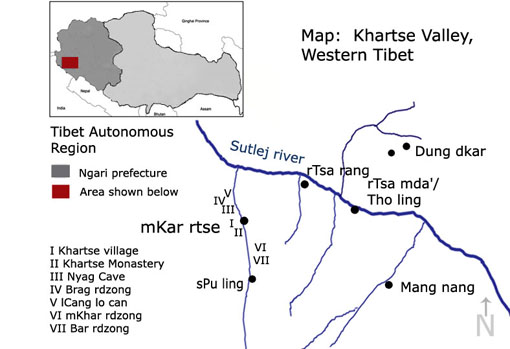
Map of Khartse Valley, Western Tibet (Ngari Prefecture, Tibetan Autonomous Region (map : Ch. Kalantari)
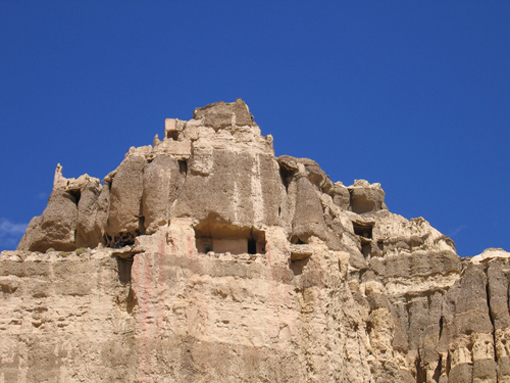
Fig. 4. Cliffs with entrance to the mKhar rdzong cave
<3>
The interior decoration indicates strong links with religious concepts of Tibetan Buddhist schools in Central Tibet (Fig. 5).
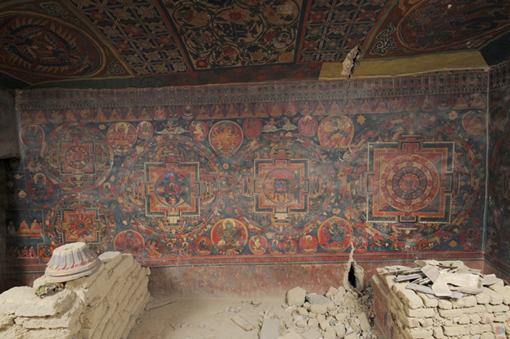
Fig. 5. View of the main/north wall
These schools, for example the »Bri gung bKa« brgyud pa (pr. Drigung Kagyüpa), appeared in Western Tibet from the 13th century onwards. In these religious traditions idealized portraits of the teacher or hierarch of the individual order – conceived as manifestation of the Buddha – surrounded by monks of his school play a central role. The wall paintings on the northern wall show a double portrait of the noble image of Butön (Bu ston) Rinpoche, who lived between 1290 and 1263 and was the abbot of Shalu (Zha lu) monastery in Central Tibet. He is shown giving dharma instructions, indicating his importance as a teacher, and wears the characteristic red hat and sumptuous robe of a lama. In the interstices in the upper zone there are the portraits of eminent teachers of previous periods identified by captions which include one referring to the »Great translator« lo chen, Rin chen bzang po (Rinchen Zangpo; Fig. 6) and the »Royal Lama« lha bla ma Ye shes ’od (Yeshe-Ö).
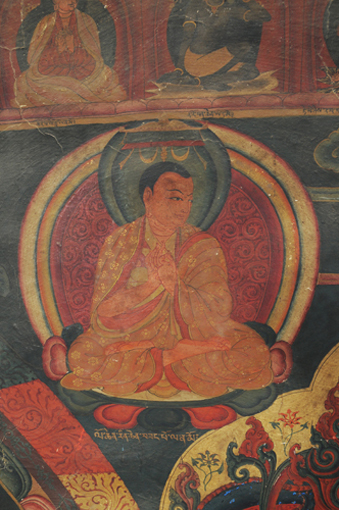
Fig. 6. Portrait of eminent master Rinchen Bzangpo
On the western and eastern walls, in mirror-like symmetry, one can see five mandalas in a row, while on the entrance wall (southern wall) there are wrathful protectors, local tutelary deities and donor depictions featuring historic personalities identified by inscriptions (Fig. 7).
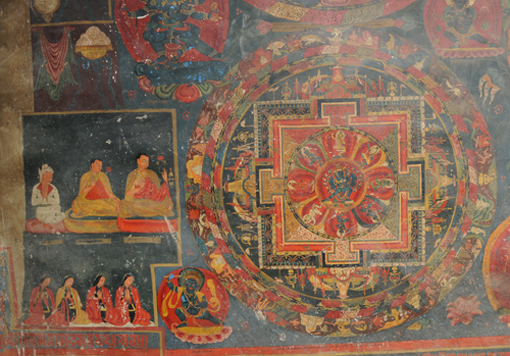
Fig. 7. West wall, donor depictions and offerings of ‘Five Senses’
The style of the presentation represents a tradition that is among the most refined and technically sophisticated in Western Tibetan Buddhist art. In contrast to earlier temples of this tradition, intensive colours predominate, with generous use of dark red, dark blue pigments as well as gold. Many elements echo earlier styles associated with the kingdom of Pu rang-Guge, displaying affinities with the »renaissance phase« of the paintings in temples at Tholing and Tabo (14th/ 15th C). One finds also affinities with 14th-century Chinese textile traditions which may have provided models for the ceiling decoration, as will be discussed, giving additional clues to the dating.
<4>
The Kardzong cave is unique in this area as it preserves the ‘original’ decorative programme with its ceiling paintings intact. When standing in the temple and looking up to the ceiling, the onlooker receives the impression of a patchwork-like surface decoration seemingly resembling a canopy or tent made of textiles (Diagram; Fig. 8).
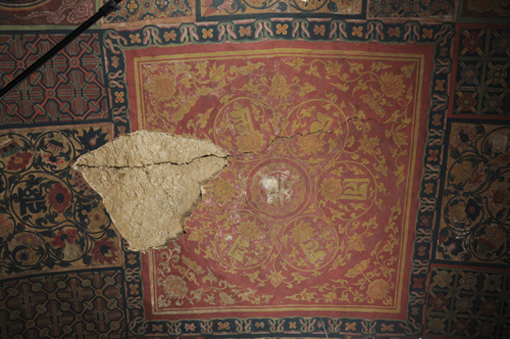
Fig. 8. Central ceiling panel showing a flower rosette containing the ‘Avalokiteshvaramantra om mani padme hum hrih’
However, a closer examination as a part of the overall architectonic structure reveals that this system of decoration developed within a rich and refined tradition of construction traditions and ceiling compositions, the latter being a constant theme in the Buddhist temple art of the region.
<5>
At Khartse the ceiling decoration is painted directly onto the rock surface of the cave temple and consists of nine rectangular squares organised in three rows, thus forming an orthogonal grid system. The organisation in rectangular panels clearly preserves the memory of local architecture constructed of mud-bricks, stone rubble and timber beams decorated with different textile paintings between the wooden elements of the ceiling. [13] These paintings of textiles organized in a symmetric grid at Khartse thus allude to an architectonic unity with a pseudo-lantern-like centre placed on a system of beams and rafters. A comparable example of this type of centralised ceiling design – representing a hierarchy towards the centre and symbolically honouring and elevating the focus of worship below - where often a stupa or main icon is placed - can be found at Lalung/ Spiti (ca. beginning of the 13th C). The spatial concept behind this type of ceiling design is perhaps related to the strong and lasting evolutionary history of centralised ceiling compositions which characterise accessible stupas of the Alchi-group in Ladakh. [14] In fact, at Khartse stupas of clay (today in ruinous state of conservation) are positioned in the four corners.
<6>
With regard to the motifs depicted in the individual panels at Khartse, the ceiling plan displays a centralized ‘mandalic’ layout which has a distinct hierarchical structure with the highest-ranking element at the centre featuring a lotus medallion with inscribed letters. The central element consists of a central square with smaller squares at the cardinal directions and in the corners while rectangles are placed in the interstices. Within this arrangement of compositional units following distinctive decorative themes can be distinguished:
<7>
(1) The central element (Fig. 8, cf. Diagram: ‘A’) contains the most complex motifs, namely a lotus rosette [15] surrounded by lotus tendrils forming a six-petalled flower containing letters in Lantsa script which represent a mantra. This composition is framed and emphasized by a wickerwork band. The letters represent one of the most popular Buddhist mantras, namely the Avalokiteshvaramantra om mani padme hum hrih. The mantra begins with the letter in the petal on the upper left side of the rosette and ends with the syllable 'hrih' in the centre (Thomas Kintaert, verbal communication). [16] One personification of this mantra is Sadaksari-Lokeshvara, who is depicted in the wall-paintings of the Bar rdzong (ca. 13th C) cave in the same valley (cf. Map: IV F). [17]
<8>
(2) At the cardinal directions there are four medallions each with a letter in the Lantsa script at their centres (the syllable 'hrih', which is identical with that in the centre) alluding – as already stated – to the mandalic layout of the ceiling composition. [18] The letters are surrounded by tendrils from which issue different flowers (perhaps peonies, hibiscus and lotus) on which rest the ‘Eight Auspicious Signs’ (bkra shis rtags brgyad) (Diagram: ‘B 1-4’; and Fig. 9).
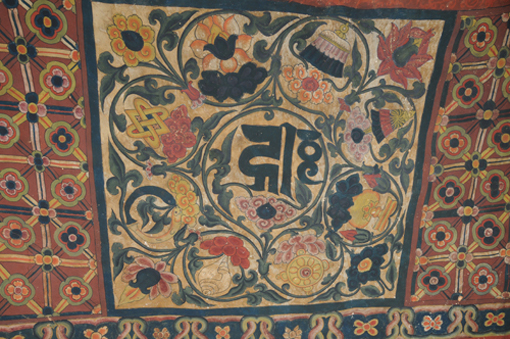
Fig. 9. Detail, Panel Group B, Ceiling medallions in the four cardinal directions showing the Eight Auspicious Symbols and a central letter (hrih) in Lantsa script
The latter are present everywhere in Tibet as lucky signs and are also used in mandala rituals as offerings. These ornaments recall earlier ceiling decorations in the ambulatory of the Tabo Main Temple (c. end of 10th C; Figs. 19.-19A.).
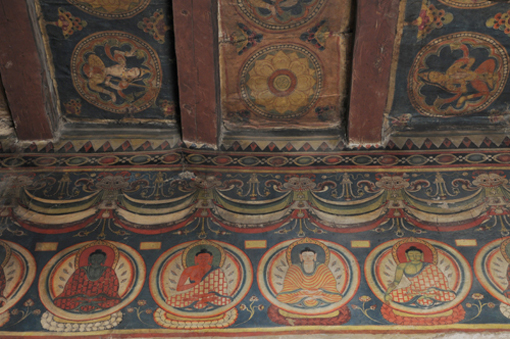
Fig. 19. Tabo, valanced above the sanctum of Assembly Hall
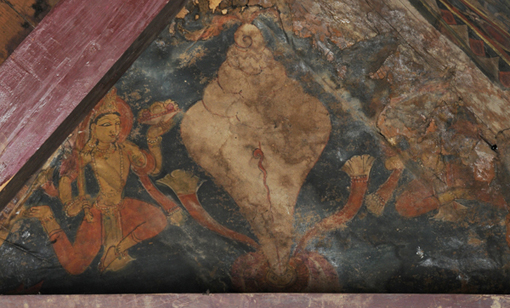
Fig. 19A. Tabo, ceiling above sanctum, detail in corner with one of Eight Auspicious Symbols
There one finds different airborne offering deities and auspicious symbols in the corners – alluding to a mandalic configuration (comparable inter alia with a ca. 10th C painted mandala from Dunhuang ; cf. Fig. 35) and thus representing a cosmological concept of space with the sanctum in its centre.
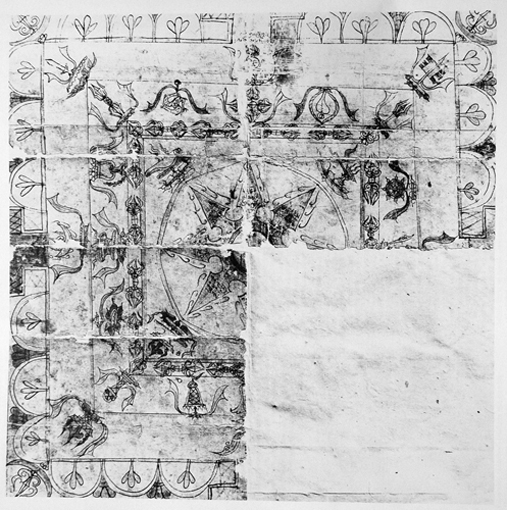
Fig. 35. Dunhuang, Mandala on paper, c. 10th C.
This complex iconographic ceiling programme in the sanctum of Tabo contrasts with that of the assembly hall of this temple, where surface patterns with symbols associated with worldly wealth and abundance (such as vases of plenty filled with flowers, heavenly bejewelled trees, lotus rosettes and cornucopia emitting jewels) predominate, showering worldly riches onto the Buddha and the devotee. [19] These popular thematic sets from an Indian religious (Hindu and pre-Buddhist) substratum were integrated into Buddhist mythology at a very early stage (cf. Papa-Kalantari 2007 [20] , 2008 [21]). In the early phase of this artistic tradition (10th – 13th C.) these popular symbols are organized as textile-mimicking patterns. Only at Tabo they are depicted on actual cotton fabrics which were fixed between the beams to protect dust from falling down. It has to be noted in this context that there is also the influential tradition of textiles in the Indian tradition to shape ephemeral ritual spaces, which is still observable today in Buddhist performances in Himachal Pradesh (Kalantari, forthcoming), and which appears to be reflected in this decorative system in the early Western Himalaya temples. Furthermore the sizes of textile strips attached to the ceiling and types or decoration observable in the Tabo Dukhang can be compared with early Indian ceremonial banners from Gujarat for the Indonesian market (Papa-Kalantari 2008, see note 21: Fig. 26; Ruth Barnes, Oxford, Ashmolean Museum, verbal communication 2002). [22]
<9>
(3) By contrast, the four corners at Khartse are inhabited by images of possibly Chinese-style dragons [23] and phoenixes encircled by rainbows and clouds indicating the celestial sphere (Diagram: ‘C 1-4’; Figs. 11 and 12); the latter motifs are found in the later Tabo Brom ston Lhakhang (Spiti, ca. 15th C) protecting the ceiling space above the entrance to the temple. A counterpart to these Chinese-style mythical creatures in the Tibetan realm can also be found in the same cave, namely naga (serpent spirits), which are in addition often depicted as supports of thrones of deities (Fig. 12 - 14).
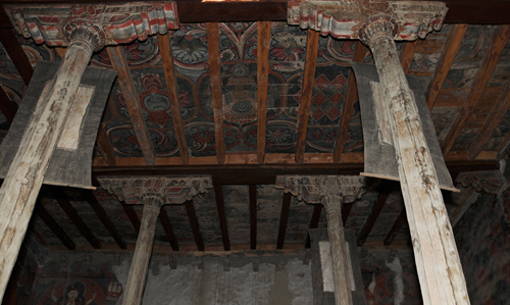
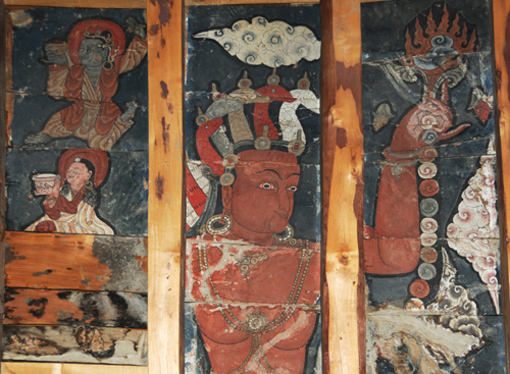
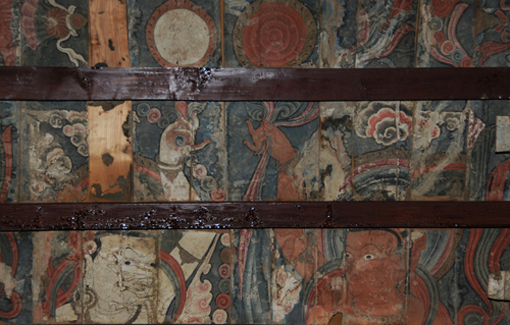
Figs. 12.-14. Tabo (Spiti, Himachal Pradesh), Dromtön Lhakhang
They are responsible for controlling the weather. Thus - despite inhabiting the underworld - the ceiling is a suitable place for their representation. Like the Indian and Tibetan naga the legendary Chinese dragon has a strong affinity with weather control. [24] Two roundels show phoenixes in flight with their long necks turned towards each other in a kind of yin-yang form. Dragon and phoenix are ancient Chinese astrologic and geomantic symbols equated with the cardinal directions. [25] Thus the temple alludes here to a celestial world reflecting early concepts of nature and cosmogony as integrated into the Buddhist world system. These mythical creatures are also frequently found as motifs on contemporary liturgical textiles (see below) and at the zenith of ceilings of early Buddhist cave temples at Dunhuang and also – in closer temporal and geographic proximity – on the ceilings of cave sanctuaries at Dungkar (ca. mid. 12th C, Figs. 41-42). [26]
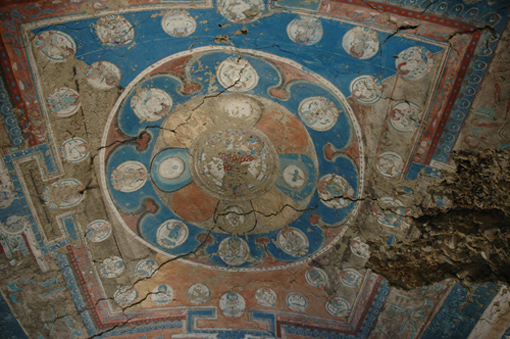
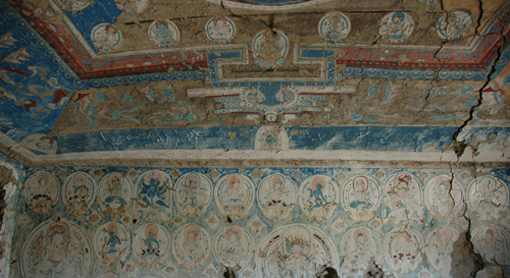
Figs. 41.-42. Dungkar, Ceiling, ‘Small Cave A’
<10>
(4) Between the latter two types of panels at Khartse are complex ornamental surface patterns, such as linked squares with circles – perhaps echoing vases (bum pa) of earlier (10th -12th C) phases – together with rosettes in strict geometric configurations (Diagram: ‘D1-8’; Figs. 15 and 16).
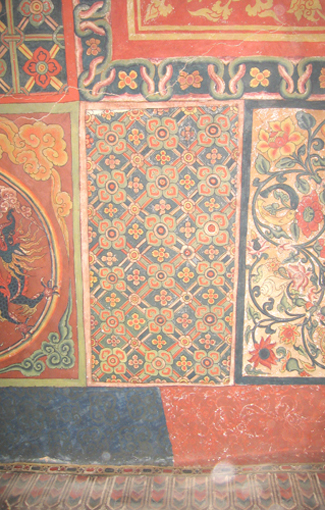
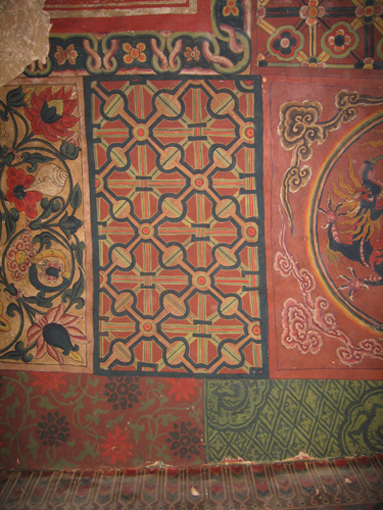
Figs. 15.-16. Textile depiction in the interstices (Group D)
The dominance of flowers and lotus rosettes in particular on Western Tibetan ceilings of various phases may echo symbolism of the Buddha as well as the practice of flower offerings which is essential in Buddhist ritual and worship. Lotus medallions in pearled circles which are depicted at Tabo are a key element in the depiction of the sitting textiles of the Buddha in early Kashmir-style art. [27] These complex motifs alluding to luxury textiles are often found on the temple’s ceilings - the celestial throne of the Buddha - which contrast to the textile motifs found in the wall paintings (Papa-Kalantari 2007, see note 20). [28] There are also significant parallels to the rich tradition of Kashmiri-influenced Indian wooden temples, one important example being the Mirkula Devi temple in Udaipur (Lahaul-Spiti; cf. Papa-Kalantari 2007, see note 20: Fig. 18), featuring extremely find padma (lotus blossoms) and celestial gandharva in the corners of the wooden ceiling.
<11>
Regarding the function and meaning of the individual compositions in the Kardzong temple at Khartse and their relation to the overall programme, the side panels containing the »Eight Auspicious Symbols« – recalling actual honorific covers or canopies [29] – may have been designed to honour the stupas below as well as the two main deities in the temple of which today only the thrones remain.
<12>
Comparative material of such honorific cloth made of luxury textiles is provided by a sumptuous, large size silk in an Austrian private collection (Sammlung Dr. Prammer), which was exhibited on the occasion of a seminar held by the Austrian Society for Textile Art Research (TKF) in September 2010 (Figs. 21 and 21A) at Schloss Aschach (Upper Austria).
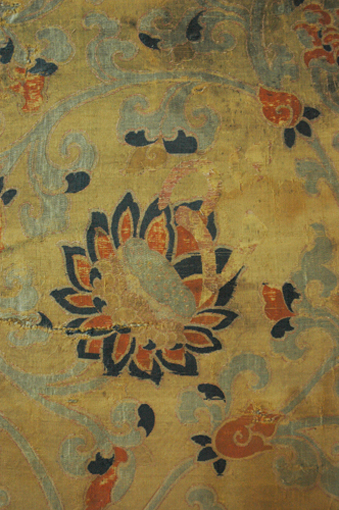
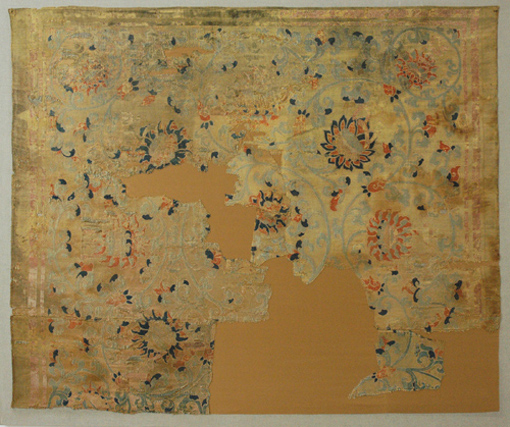
Figs. 21.-21A. Sumptuous silk textile (honorific cover or baldachin), Ming-period, collection Dr. Prammer
The rectangular textiles of silk features a centralised surface pattern with middle rosette and lotus tendrils with flowers growing out of it on which rest letters, perhaps lantsa script representing the mantra om mani padme hum hrih, found also in the zenith panel at Khartse. The complex configuration forms a large medallion decorating the gold-colour silk ground in a colour palette of light blue, dark blue and red. Another example from the same collection features a surface pattern with stylized lotus rosettes (with characteristic eight petals in the centre), linked in a geometric grid system (Fig. 22), the latter can be compared with the ornament of ‘group D’ at Khartse (Fig. 15). [30]
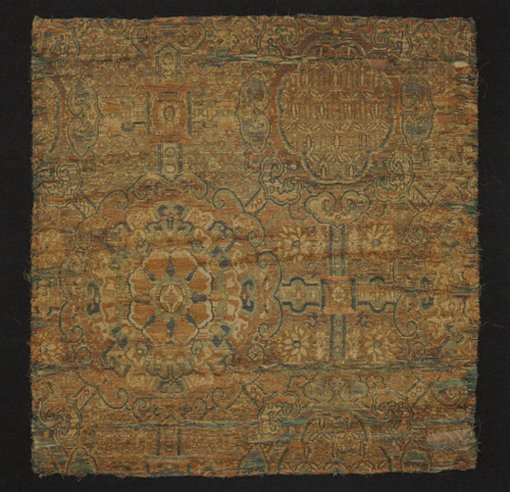
Fig. 22 Chinese Central Asian luxury cloth of silk, collection Dr. Prammer
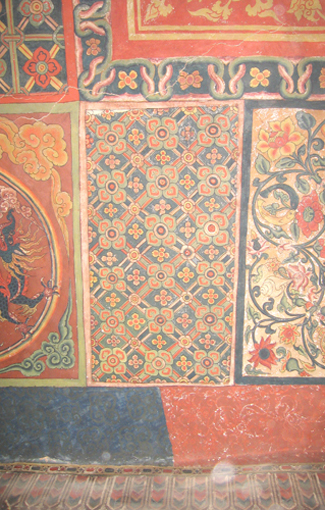
Fig. 15. Textile depiction in the interstices (Group D)
<13>
The central and main medallion – or honorific cover – containing letters in the Lantsa script at Khartse is depicted above the central space in the temple, which is empty today. The composition of the Avalokiteshvaramantra om mani padme hum hrih (»Hail the Jewel in the Lotus«) at the centre is an important component in the overall programme of the temple and represents a central component and higher truth of the Buddhist belief system (cf. also Fig. 17). [31]
Fig. 17. Khartse, Cang lo chen cave temple, ceiling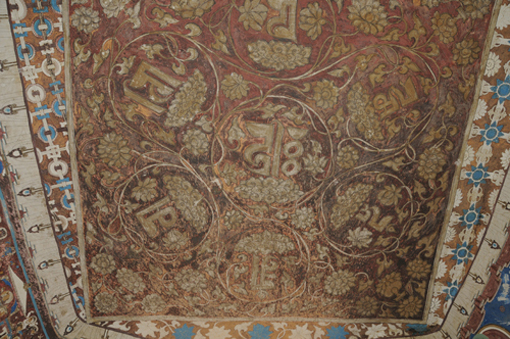
The holy letters or ‘vocal sounds’ in this cave are ‘enthroned’ like deities on a lotus and they may reflect Tibetan ritual practices of meditation, recitation and visualization by the Buddhist devotee in the temple. I cannot get here into the complex factors which resulted in the importance of the written word in Tibetan culture and the different layers of meanings of letters decorating Buddhist architecture. However. ‘Words as icons’ are a central component in Tibetan realm considering the fact that virtually all Tibetan literature is religious. “Tibetan Alphabet was adapted from an Indian model in order to translate the Buddhist canon into the Tibetan language […]” and therefore “ […] all writing is surrounded by an aura of the supernatural”. [32]
<14>
(5) At the borders of the Khartse ceiling is an assemblage of strips decorated with different ornamental patterns (Diagram: ‘E1-12’; Figs. 15 and 16), while (6) on the uppermost zone of the wall displays valances of textiles forming a continuous frieze (Diagram: F; Figs. 5 and 16), constituting a constant theme in the decorative programme of temples in this region (cf. the c. mid 11th C Nyag cave temple/ Nyag phug pa at Khartse: Figs. 18.-18A; and the 10th 11th C Tabo Assembly Hall: Figs. 19-19A.).
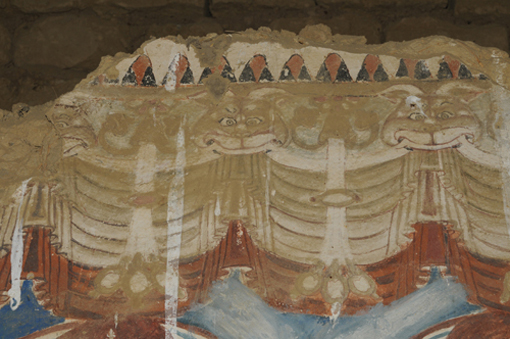
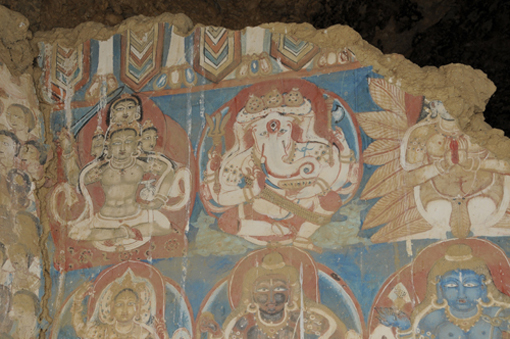
Figs. 18-18A. Nyag temple, valances (c. mid 11.th C)
They recall the old tradition of mythical beings such as kirttimukha [33] – terrifying masks, emitting pearls and textiles – which have a protective and wealth-bestowing function. These themes form an important element in Indian architectural ornamentation and are frequently represented on pillars, thrones, shrines, lintels and as the uppermost element on torana (gates), marking and protecting the sacred sphere of gods as opposed to the world of wilderness and nature (cf. Lehner 2006 [34] : 143). [35] Thus painted valances in the uppermost zone are reminders of an architectonic relationship. These jewel-encrusted textile hangings also echo the cultic context, namely ritual practices of precious textiles and valances (dra ba [dang] dra phyed) made of silk brocades offered to the temple by pious devotees, which have constituted an important aspect of the aesthetic-sacred space of Tibetan temples since earliest times (for 9th C example in Dunhuang: Fig. 20) up to present day. [36]
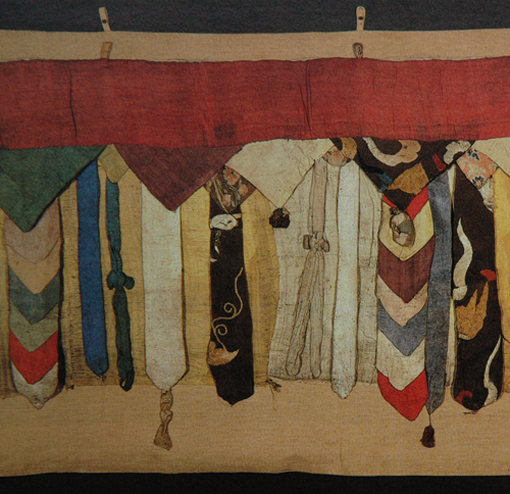
Fig. 20. Dunhuang, silk valances (after Whitfield and Farrer 1990)
They were often positioned on the uppermost elements of sacred spaces, on constructive elements and altars, and were then also translated into the medium of painting where – over and above their decorative and honorific function – they became markers of an overall architectonic unity.
<15>
At Khartse, the illusionist representation of actual Buddhist ritual textiles and temple hangings is particularly dominant, reflecting the long tradition of textiles as objects of merit, meditation, devotion and trade, which has resulted in Buddhist temples being today among the most important depositories of medieval luxury textiles. [37] In terms of both style and technique, the central panel recalls damasks or precious textiles decorated with embroideries. Additional interesting comparative material is provided by ritual garments from the important silk-producing centres of the Yuan dynasty (1279-1368). A canopy in the Metropolitan Museum decorated with threads of gold, typical of the Yuan period, is of special interest in this context (cf. Watt & Wardwell 1997: Pl. 60; p. 196). [38] The paired confronting phoenixes in flight shown on it strongly recall the mythical beings depicted on the corner panels at Khartse. While the complex ornamental patterns at Khartse (squares and linked circles) recall Chinese brocades from later periods (cf. Gao Hanyu: 1992: fig. 121) [39] , some of the small-scale patterns can again be compared to silk damasks [40] from the Yuan period (cf. Watt and Wardwell 1997, see note 38: fig. 42, p. 153). Characteristic of the latter type of pattern at Khartse are lobed roundels encircling a coiled dragon against a background of tiny squares (Fig. 16). The presence of this type of textile tradition as a possible model for the Khartse ceiling can be historically linked to the strong Sino-Tibetan relations which prevailed under the Yuan dynasty (during the 14th century Yuan silk textiles were transported as far afield as Italy; ibid. 18). This shows that textile depictions in Western Tibetan and Western Himalaya temples constitute a hugely important resource for issues of material culture, trade relations and cultural interactions and thus also for the dating of the temples.
<16>
The illusionist textile paintings on the ceilings play an important role in the decorative systems and symbolism of Buddhist sacred spaces in the Western Himalaya and Western Tibet at different periods. In the early phase (10th to 12th C) there is a predomination of textile depictions emphasizing the architectonic structure and its boundary, while in later phases, such as Dungkar (13th C.), as will be shown, we find a synthesis of the latter architectonic system with mandalic structures and cosmological symbols alluding to a Buddhist heaven. However, in contrast to conclusions in previous research, the architectonic constructive unity is never undermined in the early Buddhist artistic phase from 10th to 13th C.; thus Klimburg-Salter’s generalized canopy-interpretation for the Tabo (1997, see note 8) and Dungkar-ceilings (2001, see note 9) has to be refuted. Collating new data from examples of this genre of painting during different periods as a single corpus allows a fresh perspective and the interpretation of the structural principles of ceiling designs. The results shows that only in later periods (from the 15th C onward) we find illusionist depictions opening the constructive borders of built space and mimicking a honorific cover or canopy, as shall be shown.
<17>
Consistent features in various periods are textile motifs, which enhance the visual richness and colourful splendour of sacred space. They reflect the long history of decorating and thus dignifying the Buddhist temple with sumptuous draped cloths and religious hangings – including baldachins, circular banners of silk (rgyal mtshan), silk brocades with gold and silver threads (gya ser) wrapped around pillars, decorating thrones and ceilings, used in ceremonies, and honouring the deities – and indicate the high status of textiles in Tibetan culture. They have constituted an important aspect of the aesthetic space of Tibetan temples up to the present day. As a result of the liturgical value of ritual cloths, over and above their economic value, Tibetan temples became one of the most important repositories of precious medieval textiles, and are thus of huge significance for the ongoing reconstruction of their evolutionary history in Tibet, India, Inner Asia and China. [41]
<18>
In the Buddhist ritual context, there is ample evidence for the importance of offering textiles as an act of merit in Buddhist texts since earliest times. Judging from the great number of banners and votive textiles found at Buddhist cave sites along the southern Silk Road in eastern Central Asia, in Tibet and depicted in the temples discussed here, the devotees believed the promise in a speech of Maitreya to his followers on the acquisition of merit by making offerings of precious cloths: »It is because you have worshipped Shakyamuni with parasols, banners, flags, perfumes garlands [...] that you have arrived here to hear my teaching« (Conze 1959: 240) [42] ; (Fig. 23).
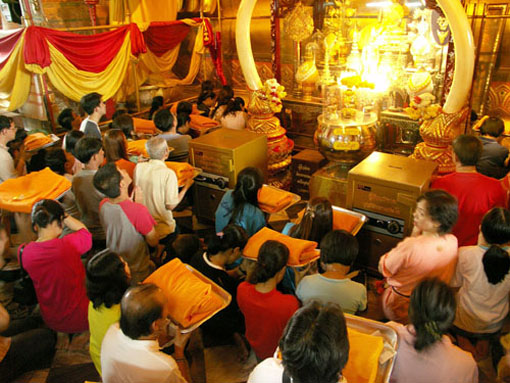
Fig. 23. Ayutthaya, worshippers offering textiles (photo: E. Lehner)
<19>
There is ample evidence for the practice of offering textiles in ceremonial and devotional rituals. Piles of fabrics are likewise shown in donor depictions at Tsparang, Red Temple, documenting offerings of textiles to the temple (Papa-Kalantari 2007, see note 20; Fig. 24 and 25-25A).
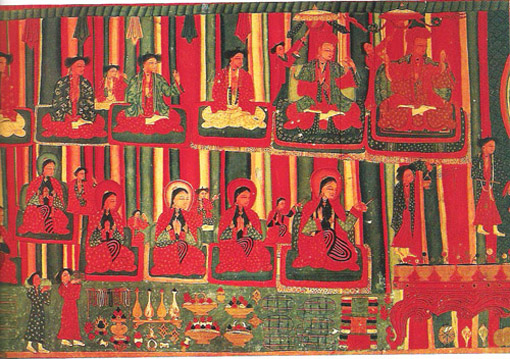
Fig. 24. Tsaparang, donor depiction with precious offerings, among them silks (photo: L. Fournier)
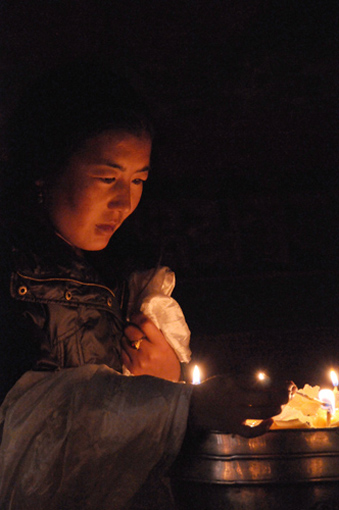
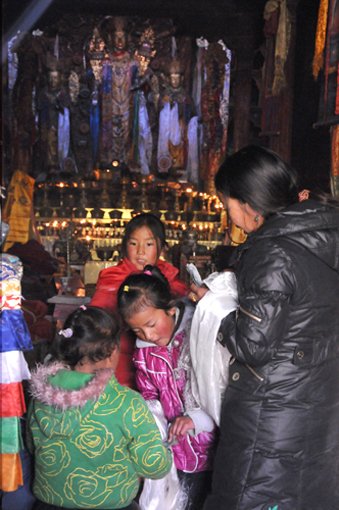
Fig. 25-25A Khorchags, offerings of kataks (photo: Christiane Kalantari)
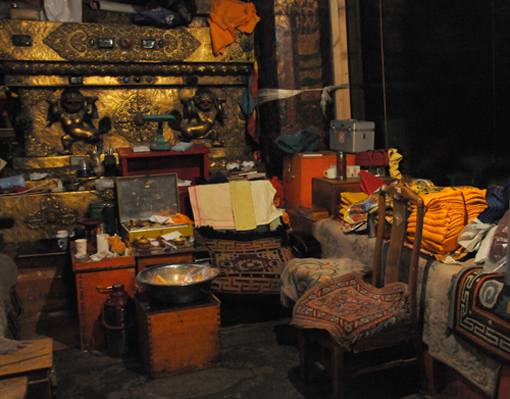
Fig. 26. Lhasa, Jokhang, space for the purchase of precious silk garments for the `namze´ of the Holy Jobo statue
Furthermore, the donation of precious fabrics is mentioned in inscriptions at Wanla (Ladakh, 13th-14th C; cf. Papa-Kalantari 2007: 151). Whether used as ritual paraphernalia or translated into the medium of painting, textiles are thus charged with the ‘religious aura’ and power through their liturgical use, material value and personal veneration by the devotee. In the Lhasa Jokhang a space near the sanctum is specifically dedicated to the distribution of luxury textiles of silk (as well as gold pigments), to be offered to the central focus of worship for Buddhist Tibetans, the Jowo image, in exchange with offerings (Fig. 26). There the devotee receives pieces of old namze (robe of silk brocade) from the Lama as contact relics (Fig. 26). Offering silks are also tailored to dresses for sculptures and other religious paraphernalia in the temple (Figs. 27 and 28).
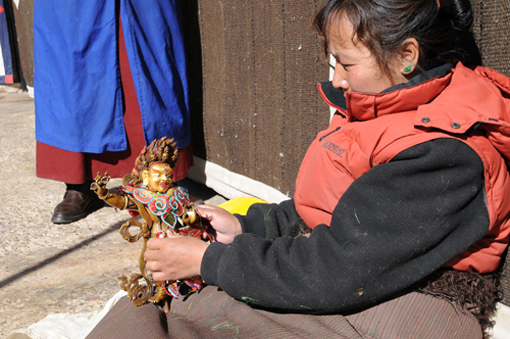
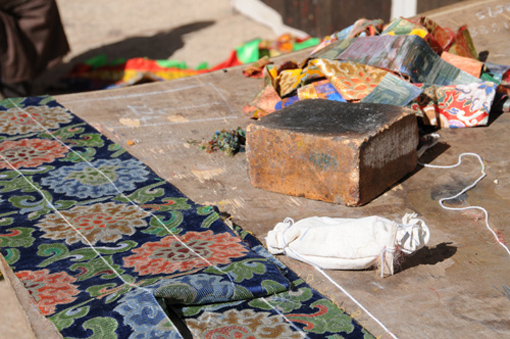
Figs. 27-28. Offering textiles tailored to robes for deities and ritual paraphernalia in the temple
<20>
Furthermore the representation of textiles, banners, scarfs and umbrellas (gdugs) on images of thrones, celestial palaces, stupas (Figs 29 - 31) and ceiling paintings in early Buddhist temples of the Western Himalaya and Western Tibet provide important insights into the ritual dimension of Buddhist practice and into personal forms of religious devotion.
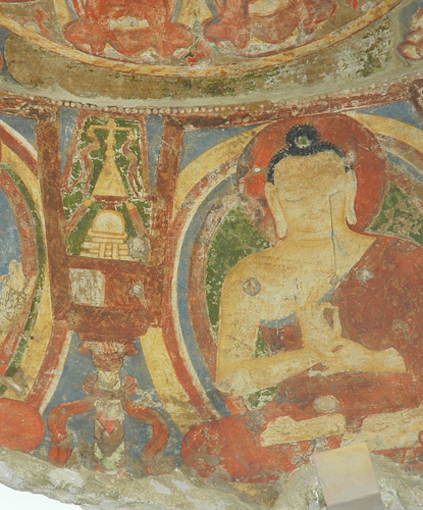
Fig. 29. Kakrak (Hindu Kush, ca. 7th C), ceiling depiction, pillars ‘attired’ with precious cloths (Musée Guimet)
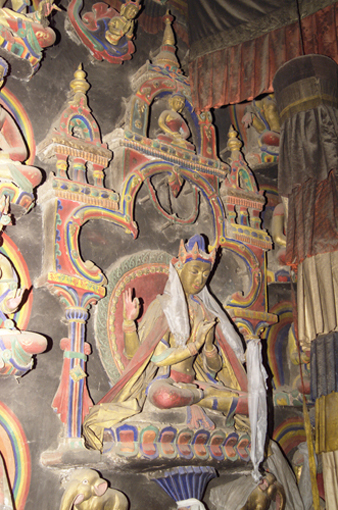
Fig. 30. Lalung, heavenly throne hung with textiles
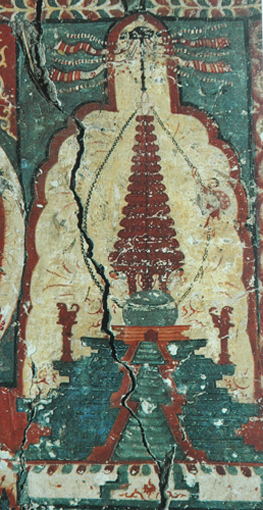
Fig. 31. Alchi, Sumtsek (Ladakh, ca. 1200), stupa depiction attired with textiles
They recall various passages in the Lotus Sutra in which the veneration of the stupa with precious cloths is described as most meritorious. There is also the important aspect of the stupa containing the relics of the Buddha. The stupa thus became a monument recalling an enduring substitute for the bodily aspects of the Buddha and the everlasting memory of His miraculous secret power (‘Der Stupa als Bauwerk ist für die anikonische Darstellung des Buddha in der indischen Kunst […] dauerhafter Ersatz für den sterblichen Körper, in dem nun eine geheimnisvolle Kraft verewigt wird’, Ebert 1985: 41). [43] In this concept of space in the temple – and in analogy with the symbolism of the stupa – textile depictions in a Buddhist temple may also allude to the attire of the Buddha and his dharma body (body of the teaching), veiling and unveiling the Buddha's secret nature, which is beyond physical reality and thus cannot be portrayed. [44]
<21>
On a higher symbolic level, textiles on the ceiling echo the honorific function of the umbrella indicating worldly and spiritual sovereignty [45] : Atisha, the famous Indian master, who arrived in Western Tibet in 1042, was reputed to have been entitled to a retinue of thirteen umbrellas which ‘honorifically elevated his spiritual status to that of a Buddha’ (Beer 2003, see note 24: 182). [46] However, in the Western Himalaya temple, also the symbolism of local traditions of ephemeral dwellings and ritual fabrics protecting, marking and honouring the sacred area and defining a religious space has been continued. [47] Sacred spaces defined by carpets, precious hangings and thangkas are as well a constant theme in contemporary Buddhist theatrical performances by the Buchen in Spiti (Cf. Kalantari [48] ).
<22>
Textile depictions also indicate that that sacred space is not solely defined by built architecture and – perhaps equally importantly – by the iconographic programme and pantheon of deities, which generates a precisely ordered three-dimensional space other forms of imaginary ideal space in which the plan of the mandala plays a central role. Temples also take up and continue the memory of ephemeral architecture and precious honorific textiles defining sacred areas and holy places, and transform the dwelling into a virtual celestial throne or palace.
<23>
A related dimension relevant in this context is the function of textiles in various ceremonies and consecration rituals in which vases (bum pa) – containing various precious substances and consecrated waters embodying the visualized mandala of deities (Beer 2003, see note 24: 199) – and pillars or wooden posts with textiles draped around them play a significant role. This important aspect of the consecration of the sculpture or temple may also be reflected in representations of the thrones of deities at Bamiyan, Kakrak (both in the Hindu Kush, Fig. 29), Dunhuang, Tabo (mid.11th c.; Papa-Kalantari 2007, see note 20: fig. 19 and 27) and the chronologically slightly later Lalung (Fig. 30) (in the Western Himalaya), which are all attired with clothes. [49] The textiles draped around the vase and the throne-pillars may honour the deities ‘dwelling’ in them or vases of life-sources in general. [50]
<24>
A unique painting in the Alchi Sumtsek (Ladakh, ca. 1200; Fig. 31) shows a man climbing up a rope or chain and carrying on his back a large piece of cloth. [51] It may not only reflect the act of offering a ritual scarf to the stupa but perhaps it also alludes to the final phase of consecration ceremony, comparable to the Hindu temple, when the vase and the banner are positioned on the top of the temple (shikara). Above the man is an umbrella from which bells (ghanta) are suspended – disseminating the sound of the dharma – as well as long streamers with patterns recalling resist-dye techniques known as batik, the motifs of which are also found on the ceiling of the Alchi Sumtsek. The stupa depiction is another sign that the presence of the Buddha in its architecture continued to be important, and the architecture to assure that contact with Him is present.
<25>
On the level of personal veneration and popular religious traditions textile depictions also reflect the aspect of the interaction between the devotee and the holy image (sku rten), as an important component of Buddhist practices. Textiles such as precious clothes made into robes and in particular small scarves of silk kataks (kha btags) are offered by the faithful to the deity, wrapped around his body in direct contact with it, and may be given back to the devotee by a religious dignitary. In this way objects are ‘charged’ with the blessing and power or protective qualities of the image or a charismatic person and are transformed into ‘contact relics’ (Figs. 25.-25A). [52] Depictions of material culture, textiles, jewellery and ornaments in the temple thus not only mark, embellish and honour sacred space. They also indicate that it is through offerings and liturgical paraphernalia in rituals as well as sensual interaction with the holy image (sku rten) on the part of the Buddhist devotee with objects such as precious silks that the majesty of the Buddha and his teaching unfold their full significance. All these elements reflect the vividness, sense of joy, beauty and sensuality for which the softness of silk is exemplary, constituting an important aspect of the cultic dimension of Buddhism in Tibet.
<26>
Another important aspect related to the donation of precious silks in Tibetan culture is the concept of offering of ‘Five Senses’ which can be found in an image depicted above the donors in offering mode in this cave (Fig. 32).
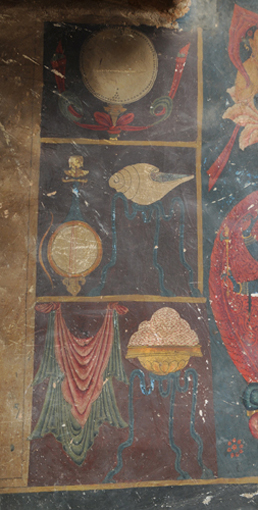
Fig. 32. Khartse, mKhar rdzong, depiction of the‘Offering of the Five Senses’
The ‘Five attributes of sensory enjoyments’ also denominated as ‘Five Desire Qualities’ (‘dod yon sna lnga) which form a group of the most beautiful objects which can attract the five senses of sight, sound, smell, taste and touch (reg bya). Among these offerings that of touch is typically represented as a silk cloth. [53]
To summarize the Kardzong’s ceiling design displays a strict architectonic system with inserted ornamental patterns alluding to textiles of merit and meditation which include symbols of iconographic value signigicant for the overall programme and spiritual concept of sacred space.
<27>
In the last part of this paper we shall provide a comparative analysis of the above discussed cassette type of ceiling composition in the Kardzong with a contrasting type of ceiling design in the same valley, providing an important example for a completely different relation between ornament and architecture. The latter can be found in a small cave temple, provisionally denominated as Tsülgye Cave which has been discovered by Tsering Gyalbo during a documentation campaign in 2010, dating perhaps to the 14th or 15th century. The ceiling depictions of this cave display a composition with a unique decorative programme, which – to our knowledge – has not yet been analysed or documented (Fig. 33-37A).
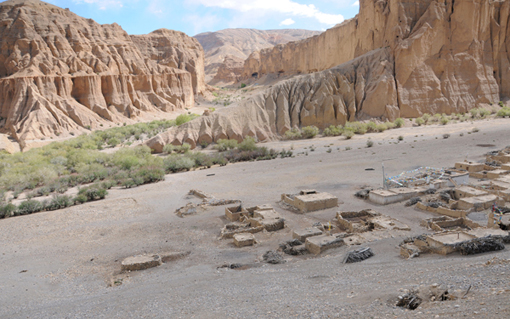
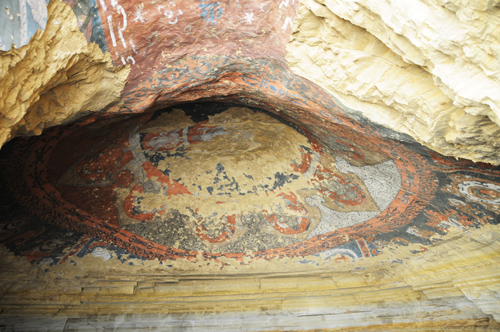
Figs. 33-34. Location of Tsülgye (Tshul skyes) and path to Tsülgye Cave and view from entrance inside

Fig. 35. Dunhuang, Mandala on paper, c. 10th C.
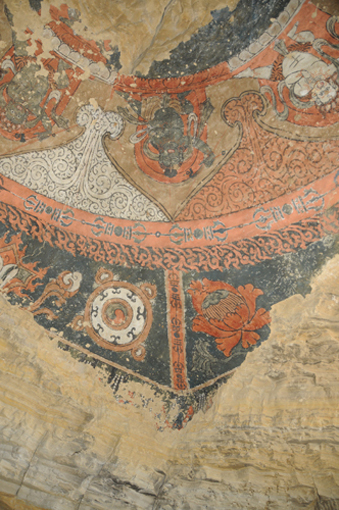
Fig. 35. Dunhuang, Mandala on paper, c. 10th C.
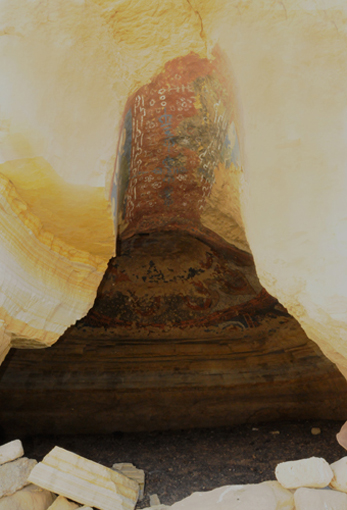
Figs. 36-37A. Tsülgye Cave, internal views
The entrance of the cave is in the shape of a corridor with a barrel-vaulted ceiling, featuring textile patterns, which mimic printed clothes attached to the ceiling. Fragments of figural paintings can be seen below. This type of vaulted corridor can be compared with the ca. mid. 12th C Zhag cave in Pedongpo Valley near Dungkar. [54] However - in contrast to the latter - the lower parts of the Tsülgye Cave are badly damaged leaving only the rocks exposed. Local people informed that the floor is covered by debris and that the space was used as a shelter for animals resulting in a damage of the lower parts of the wall. It is also possible that the wall-decoration has never been completed. [55] From the remaining ceiling decoration, which is luckily almost intact, one can assume that there was perhaps originally no clear articulation of wall and ceiling as separate units in terms of built structure. Rather the decorative scheme generates a distinctive ‘imagined’ architectonic unity designed to shape a religious space which contrasts to earlier designs which are consequently subordinated to the local architectonic structures of mud-walls and timber roof. The wall-paintings of which no traces are left had a crowning element of valances decorated with strings of pearls. These valances allude to an architectonic unity namely solid walls and an uppermost border decorated with textile hangings, as already discussed. When the practitioner enters the religious space he has the impression of painted pilasters or poles on four sides of the walls on which rests a circular medallion representing a honorific cover made of a precious material. Between these pilasters, which may mimic poles of the honorific cover or baldachin - resting on the corners of the lower square space - is depicted the well known group of ‘Eight Auspicious Symbols’ (T. bkra shis rtags brgyad) on a dark background. The space between baldachin and valances obviously alludes to an open space: thus the walls illusionistic open to heaven, covered by a honorific cloth; this principle is very much in the tradition of Buddhist cave temples in Dunhuang (Figs. 38-40; Papa-Kalantari 2000, note 15: Fig. 12).
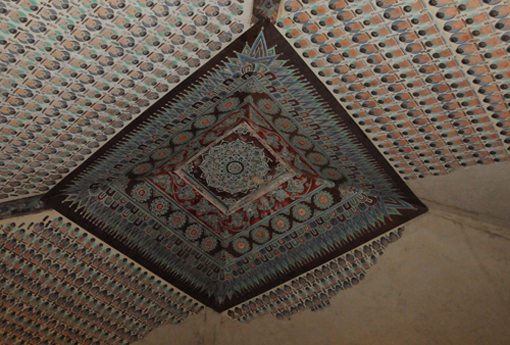
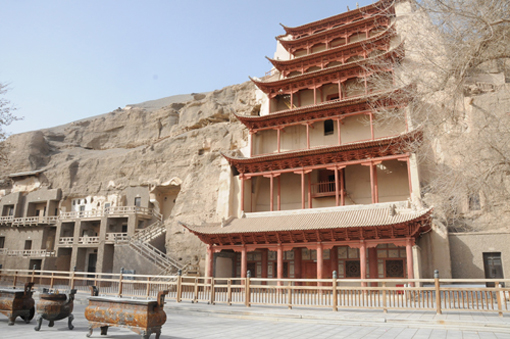
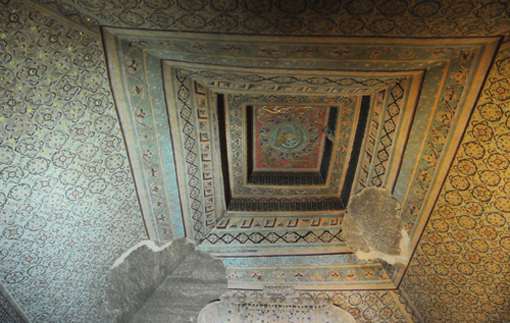
Figs. 38-40. Dunhuang, Mogao Caves
Interestingly, these pillars are organized mainly on the back part of the space and also the auspicious objects between the poles are arranged to satisfy a standing point in the centre and looking on the back wall of the temple on which was perhaps attached the main icon. Comparative material for the relation of painting and architectonic layout, namely the combination of a centralized mandala ceiling composition on an arched surface, is provided by a small cave temple at Dungkar; also the layout of the mandala featuring a lobed medallion with inserted deities in the petals is similar (Figs. 41 and 42).
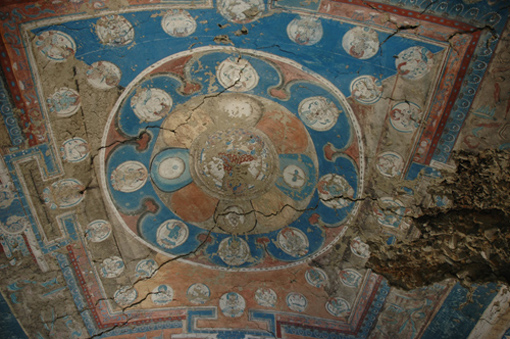
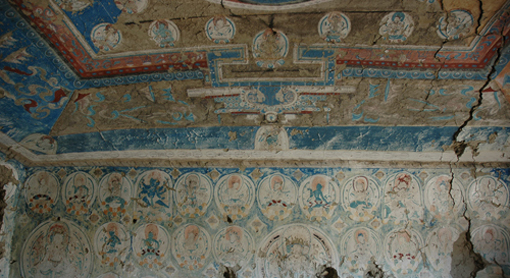
Figs. 41.-42. Dungkar, Ceiling, ‘Small Cave A’
<28>
The medallions in both temples show in the central region instead of a lotus rosette – on which is usually based the mandala - a medallion with eight spokes recalling a vajra-wheel. A diagram for a mandala (perhaps a visual aid for a ritual) from Dunhuang (ca. 10th C; Fig. 35) is perhaps the ultimate model of this type. In the outermost rectangular level are the ‚Eight Auspicious Signs’, which are also to be found in the outer spheres at the ceiling of Tabo above the sanctum (Fig. 19A). The Tabo ceiling above the cella (end of 10th C) is thus perhaps the first concrete indicator of a mandalic configuration of space in a Western Himalaya temple, circa dating from the same period as the Dunhuang mandala.
<29>
The small Dungkar cave contrasts to the larger caves at this site, where one finds ceiling structures featuring complex stepped surfaces, alluding to a pseudo-lantern ceiling and also to an architectonic system imagined in a mandala palace, which are also to be found in contemporaneous ceiling concepts at Alchi (Ladakh, India, ca. 1200). Many elements at Dungkar stand in the tradition of Central Asian ceiling designs (e.g. the Western Xia cave 3 in Yulin), and also take up many motifs such as cosmological hybrid creatures. However in the early Western Himalaya phase the Central Asian illusionist baldachin ceilings of Dunhuang and Yulin are never taken up. [56] In this early Indic phase in the Western Himalaya, textile depictions are clearly subordinated to local architectonic systems and never allude to a unified honorific cover.
<30>
In contrast, a key element in the Tsülgye-Cave not found in earlier cave temples at Dungkar - is the combination of an illusionist baldachin and a mandala composition. The central ceiling medallion representing a mandala at Khartse shows an outer fire ring (appearing like fringes of a carpet or textile) and a vajra ring, framing a ten-petalled flower-like rosette in which are arranged wrathful deities around a central roundel in which is enthroned the main icon; in the interstices are ornamental elements alluding to textiles; while in the small cave at Dungkar no textile elements are depicted on the mandala ceiling; here limits of space are transcended based on the concept of the cosmologic diagram for which the mandala is exemplary; this concept contrasts to textiles depictions between the imitated wooden elements of the mandalic ceiling designs in the larger caves in this valley (Papa-Kalantari 2007, see note 20: Fig. 30) emphasising local architectonic concepts. The medallion at Khartse displays a colour scheme indicating four quarters representing the cardinal directions. Furthermore the ceiling is arched which - in addition to the structural function - enhances the mandalic hierarchy towards the centre with the central deity in the highest position.
<31>
This religious programme recalls – as already stated - ceiling depiction at Yulin (Xinjiang, China) combining the concept of the illusionist baldachin with an eight-petalled flower-like rosette containing a mandala configuration; one example at Yulin (Cave 10) features the four Jinas residing in the respective directions (with intermediate Buddhas), around a central Vairocana, dateable into the Yuan period (cf. Zhao Le Nin and Luo Ke Hua, 1997: Pl. 112) [57] .
<32>
To sum up: in the evolutionary history of early Western Tibetan temples the multilayered symbolism of textile depictions and ornament is an important component of the overall programme of the temple reflecting various aspects of religious experience in Tibetan Buddhism. This attempt at analysing the individual motifs in the ceiling ornaments has enabled a new reading of their function in ceiling compositions as a part of the overall iconographic programme and markers of the evolutionary history of architecture in the region. The paper focuses in particular on the various uses of textiles in the Buddhist ritual practices and their impacts on the definition and perception of sacred space in the Tibetan Buddhist sphere.
<33>
The Kardzong at Khartse represents a unique example in the rich evolutionary history of ceiling paintings, displaying a precisely structured unity of architectonic and pictorial elements achieved by material illusions (reflecting the cultic component and veneration through precious clothes and honorific covers) and the orthogonal grid system, with its echo of architectural features. This synthesis of material illusionism, centralized plan and hierarchy of pictorial elements reflects the bond with the overall spiritual programme that culminates in the centre. The latter may perhaps represent a central truth in the programme of this sacred space. A hierarchy from the worldly sphere in the corners to a higher truth at the centre [58] – the depiction with the highest status and highest level of religious conceptual abstraction – can be observed, corresponding to the concept of the Buddhist spiritual path and realization of the ultimate truth.
<34>
Through collating new data from ceiling compositions of different phases in this region and focusing on the question of the relation between ornament and architecture the authors tried to demonstrate that, while in early phases of this artistic tradition – which I propose to term Indo-Tibetan cult-spatial tradition - textile depictions and ornament are subordinated to traditional architectonic structures, i.e. simple mud buildings with timber roofs decorated with depictions of sumptuous garments (reflecting the use of textiles in local architecture), in later phases they become true illusions of ephemerals spaces or symbolic canopies shaping, honouring and protecting sacred space, which reflect rather courtly cultures of status and religious authority of urban elites in Central Asia. From the 15th C such ephemeral structures – combined with mandala configurations as aids of visualization - were transferred also into the sacred realm, directing the view of the practitioner to a painted dome of heaven. [59]
Tsering Gyalbo: Fig. 1-11.; Figs. 15-16; Fig. 17. Figs. 18-18A. Fig. 32. Figs. 33-34. 36-37A.
Christiane A. Kalantari, Figs. 12-14; Figs. 19. -19A; Figs. 21- 22; Figs. 25- 31; Figs. 38-42.
Erich Lehner: Fig. 23.
Lionel Fournier: Fig. 24.
Jaroslav Poncar: Fig. 31.
Patrick Sutherland: Fig. 43.
Susanne Nowotny: Fig. 44.
After: Whitfield & Farrer 1990: pl. 90 (see note 6): Fig. 20.
Christiane Kalantari is Tibet art historian and researcher (FWF-Forschungsprojekt P21806-G19 ‘Gesellschaft, Macht und Religion im vormodernen Westtibet: Interaktion, Konflikt und Integration“) at the Institute for Social Anthropology (ISA), Centre for Studies in Asian Cultures and Social Anthropology (CSACSA), Austrian Academy of Sciences
Tsering Gyalbo (Tshe ring rgyal po) is Associate Professor and Director, Institute for Religion Studies, Tibetan Academy of Social Sciences, Lhasa, Tibet Autonomous Region, PR China.
[1] This study is based on field research conducted within a multidisciplinary team from the Austrian Academy of Sciences (Vienna) in Western Tibet directed by Dr. Christian Jahoda and Prof. Tsering Gyalpo, Academy of Social Sciences, Lhasa in 2006/07 and 2010 (Figs. 43-44). Travel and research were financed by the Austrian Science Fund (FWF, Research Project P21806-G19) and the Austrian Research Association (ÖFG). We wish to thank Prof. Dr. Jorinde Ebert (University of Vienna) and Prof. DI. Dr. Erich Lehner (University of Technology, Vienna) for our fruitful discussion of ideas and helpful comments on the various topics discussed in this paper, as well as Prof. Roger Goepper and Dr. Christian Jahoda for his support and critical comments at various stages in the preparation on this paper.
[2] Goepper, Roger: Early Kashmiri Textiles? Painted Ceilings in Alchi, in: Transactions of the Oriental Ceramic Society 56 (1991–92), 1993, pp. 47–74.
[3] Goepper, Roger: Dressing the Temple. Textile Representations in the Frescoes of Alchi, in: Hali, London 1995, pp. 100-117.
[4] Erna Wandl: Textilien und Textildarstellungen im Kloster von Ta pho, 10./11. Jh. (Himachal Pradesh, Indien), M.A. thesis, University of Vienna, Vienna 1996.
[5] Roderick Whitfield & Anne Farrer: Caves of the Thousand Buddhas. Chinese Art from the Silk Route, London, British Museum 1990; see also R. Whitfield: Die Höhlen der singenden Sande, München 1996: 311.
[6] G. Tucci: The Temples of Western Tibet and their Artistic Symbolsim. Indo-Tibetica III.1. The Monasteries of Spiti and Kunavar, New Delhi, 1988 (1935).
[7] D. Klimburg-Salter: Some Remarks on Canopies in Bamiyan, in: La Persia e l’Asia Centrale da Alessandro al X secolo, Roma, 1996, pp. 473-487.
[8] D. Klimburg-Salter with contributions by C. Luczanits, L. Petech, E. Wandl: Tabo, A Lamp for the Kingdom. Early Indo-tibetan Buddhist Art in the Western Himalayas, Milano 1997.
[9] D. Klimburg-Salter: Dung dkar/ Phyu dbang, West Tibet, and the Influence of Tangut Buddist Art, in: East and West, IsIAO Vol. 51, Nos. 3-4, Rome 2001, pp. 323 -347.
[10] This name is related to a specific location in Khartse Valley. A more comprehensive study of this sacred space is in preparation.
[11] Since the late 1990s, various hitherto little-known or unknown sites have been explored and initially documented in Western Tibet and in the Khartse Valley in particular: David Pritzker: The treasures of Par and Kha-tse, in: Orientations 31 (7), Hong Kong 2000, pp. 131–33; Thomas J. Pritzker: The wall paintings of Nyag Lhakhang Kharp’o, in: Orientations 39 (2), Hong Kong 2008: 102-12; Huo Wei: Newly discovered early Buddhist grottos in Western Tibet, in: A. Heller and G. Orofino (eds) Discoveries in Western Tibet and the Western Himalayas, in: Essays on History, Literature, Archeology and Art, PIATS 2003, Leiden-Boston 2007, pp. 23-39.
Explorations carried out there by Tsering Gyalpo since 2002 have brought to light the existence of further previously unknown Buddhist sites at Khartse: see Tshe ring rgyal po: mNga’ ris chos ’byung gangs ljongs mdzes rgyan, Lhasa 2006; Tshe ring rgyal po & Christiane Papa-Kalantari in cooperation with Christian Jahoda: The Buddhist Monuments of Khartse Valley, Western Tibet, in: Austrian Academy of Sciences ‘Working Papers in Social Anthropology, Volume 9, http://epub.oeaw.ac.at/wpsa9, Vienna 2009.
This paper is an extended version of an article entitled: Christiane A. Kalantari: On the relation between ornament and architecture as reflected in a Buddhist cave temple of Khartse, Western Tibet, in: Lehner, Erich & Alexandra Harrer (eds), Entlang der großen Mauer: Architektur und Identität in China und der Mongolei, Proceedings of international interdisciplinary conference at the University of Technology-Vienna 2009, Vienna 2010. A more comprehensive and detailed study of the rich and multifaceted Buddhist heritage in this valley is in preparation.
[12] To the west of Khartse Village (Map: I) the important Nyag Cave Temple (Nyag phug pa) sites (Map: III) dating back to the 11th century; cf. Tshe ring rgyal po & Papa-Kalantari in cooperation with Christian Jahoda 2009 (note 11).
[13] Originally real textiles perhaps were used to prevent dust from falling down from the ceiling as suggested by Roger Goepper (1993, see note 3).
[14] Lalung in Spiti shows an emphasis on a centralized plan with a raised pseudo-lantern-like element (which according to H. Feiglstorfer, verbal communication 8. 2010, has not a clear structural function); another interesting feature can be observed there enhancing the centralized layout, namely the absence of a niche on back wall housing the central icons as the focus of worship. The latter type can inter alia be found in the earlier (mid 12th c.) Nako temples. At Lalung an unusual ensemble of deities represented as clay images (cf. Christian Luczanits, Buddhist Sculpture in Clay, Early Western Himalayan Art, late 10th to early 13th centuries, Chicago 2004: 100 ff.) is placed on the plain surfaces of three walls, with protectors on the entrance wall, above which rests a centralised composition decorated with honorific textiles.
[15] The lotus flower is commonly associated with the Buddha; for a comparable example within a ceiling composition see cf. Alchi-Sumtsek (Christiane A. Papa-Kalantari: Die Deckenmalereien des gSum brtsegs von Alchi. Studie zu den Textildarstellungen eines frühen buddhistischen Tempels aus dem westtibetischen Kulturkreis, unpublished MA thesis, University of Vienna, Vienna 2000).
[16] The letters are written in the Ranjana or Lanydza (Lantsa) script.
[17] For images of the latter see: Tshe ring rgyal po & Papa-Kalantari 2009 (note 11). The central syllable is replaced by the image of Avalokiteshvara in the zenith depiction of the Swayamubhu stupa at Kathmandu (Nepal).
[18] This mantra often occurs in Tibetan temples on horizontal bands (Kurt Tropper, verbal communication).
[19] As I have shown elsewhere (Papa-Kalantari 2007, note 20), early ceiling systems such as those of the Dukhang at Tabo have a hierarchic structure leading from hall to sanctum, in contrast to the ca. 12th-C Alchi Sumtsek, where a centralised plan predominates cf. Papa-Kalantari 2000, see note 15).
[20] Christiane A. Papa-Kalantari: From textile dress to dome of heaven: some observations on the function and symbolism of ceiling decorations in the Western Himalayan Buddhist temples of Nako / Himachal Pradesh, in: A. Hardy (ed.) The Temple in South Asia. Volume 2 of the proceedings of the 18th conference of the European Association of South Asian Archaeologists - London 2005, London 2007, pp. 149-178.
[21] Christiane A. Papa-Kalantari: Celestial Architecture. Donor Depictions in the Spatial Iconography of the Alchi Dukhang / Ladakh. PhD Thesis, University of Vienna, 2 vols, Vienna 2008.
[22] I thank Ruth Barnes, Ashmolean Museum, for allowing me to study this material in Oxford in 2002 and for giving me important additional clues for the interpretation of Western Himalaya textile designs.
[23] The dragon (’drug) in the I Ching or ‘Book of Changes’ appears as a symbol of the strong, light giving male Yang principle of heaven, and the light giving powers of spring. As emblem of emperor of China, the celestial or palace dragon was represented with five claws, while lower ranks wore a three-clawed dragon according to Beer 2003, see note 24: 71. The imperial dragon and phoenix represented the emperor and the empress of China as symbols of heaven (Yang) and earth (Yin).
[24] Robert Beer: The Handbook of Tibetan-Buddhist Symbols, Chicago-London 2003, pp. 27ff.
[25] The four cardinal directions or four quarters of heaven were associated with the four seasons: spring corresponds to the rising sun of the east and with the dragon while the phoenix represents the south and summer (Beer 2003, see note 24: 67).
[26] In earlier ceiling depictions mythical animals of the Indian Buddhist belief systems predominate (e.g. at Nako/ Kinnaur, India), such as lions, vyala (leogryphs), elephants and horses, which are also represented in the throne or portal of high divinities (torana). They may represent the different elements of the cosmos, comparable to sculpture in Pala India – there are also affinities with throne depictions at Khartse (cf. Fig. 5) - which were adopted from the royal sphere as symbols of religious supremacy of the Buddha.
[27] Paper flowers made as offerings have been found in the cave temples of Dunhuang and a similar type of ornament can also be seen depicted on early ceilings at this site (Prof. Jorinde Ebert, verbal communication, February 2008).
[28] The padmasana (lotus-seat of enlightenment of the Buddha) at Bodhgaya decorated with lotus rosettes, can perhaps be regarded as the first ‚Buddhist textile’.
[29] This was proposed by Klimburg-Salter for Tabo (1997, see note 8: 173ff), following earlier interpretations of ceiling compositions at Dunhuang by Whitfield & Farrer 1990 and 1996: see note 6.
[30] The monumental silk from the collection Dr. Prammer measures 168 x 206 cm and is roughly dated to the early Ming period (14th – 15th C).
[31] The cult of Avalokiteshvara in Tibet was stressed in the 11th century by the famous Indian monk Atiśa, who was invited to Western Tibet by the nephew of the royal lama Yeshe ‘od and arrived there in 1042 as already mentioned (see Christian Jahoda & Christiane A. Papa-Kalantari: Eine frühe buddhistische Steinstele (rdo ring) in sPu rang, Westtibet: eine Neuuntersuchung. Bericht einer österreichisch-tibetischen Feldforschung, in: Asiatische Studien / Études Asiatiques, LXIII, 2, 2009, pp. 349-400, and Christiane A. Papa-Kalantari & Christian Jahoda: Early Buddhist Culture and Ideology. A New Perspective on a Stone Stele in Cogro, Purang, in: Orientations, Vol. 41, No.4, May 2010, Hong Kong 2010, pp. 61-68 for the earlier history of his cult in Tibet.
The popularity of Avalokiteśvara was not only stressed by monasteries and the ruling elite but also on the level of popular religious movements, such as Buddhist storytellers (Buchen, Puchen), also called mani-pa (those who recite the mani-mantra) perhaps initiated by Thangtong Gyalbo (Thang stong rgyal po) and his adept Ratnabhadra from the 14th C onwards (see Kalantari, in preparation, see note 48).
[32] Heinz Bechert & Richard Gombrich (eds): The World of Buddhism, London 1984: 244.
The same religious aura is associated with the Arabic script, which triggered the rich and complex art of calligraphy in Islam, which is also became an important element in decorative programmes of religious monuments.
[33] Mythical beings and ‘lower’ nature spirits, which also include naga and yaksha, mark the transition zone between wilderness or untamed nature and culture or domesticated space (vana and kshetra) or mundane and supramundane (laukika and lokottara), which is a basic cultural concept in both India and Tibet. Their nature is ambiguous and they are thus charged with protecting these boundaries. Cf. also the concepts of nature versus culture in Tibet, imagined as wilderness as opposed to a abdundant, garden-like landscape inhabited by peaceful animals, as reflected in the ideal land or valley of the ‘sBas yul’ (be yül); (Karénina Kollmar-Paulenz, verbal communication).
[34] Erich Lehner: Ideen und Konzepte der Architektur in außereuropäischen Kulturen, Wien-Graz 2006.
[35] Kirttimukha with nets of looped and hanging jewels also represent the complex decorative structures of the upper walls of the mandala palace (Beer 2003, note 24: 94) indicating reciprocal influence and inspiration from visionary architecture and built monuments together with their painted decorations in Tibet. Early mandala palaces in the medium of wall-painting in the region also demonstrate that textiles - draped on different elements of the structure - play an important role in depictions of imaginary ideal space in Tibet. The temple together with its decoration and symbolism were thus developed as a complex fabric of real and imagined forms.
[36] The term aesthetic space was coined by Jürgen Wasim Frembgen (curator of Islamic Art at the Völkerkundemuseum, Munich), focusing on the worship of Sufi shrines in Pakistan.
[37] A different ornamental culture can be found in the earlier temples of this region (10th - 13th centuries). There the motifs found on the ceiling also occur in other media such as wall-paintings as well as in the frames of bronzes, or as patterns carved into the wooden frames of doorways originating from the same artistic sphere. These motifs are fused with the concept of the honorific cover and allude to different Indian and Central Asian textile traditions. Behind the painting process a mastermind or designer of the overall programme can be assumed. In the case of the Kardzong, it is possible that a painter specialized in the genre of ceiling painting was responsible, as the wall and ceiling-paintings show hardly any common themes in terms of motifs and composition.
[38] James Watt & Anne Wardwell: When Silk was Gold. Central Asian and Chinese Textiles, Metropolitan Museum of Art, New York 1997.
[39] Gao Hanyu: Chinese Textile Design, London 1992. I wish to thank Roger Goepper for this reference.
[40] Damask indicates a form of decoration in which the pattern is formed the weave of warps and wefts in the same material and colour.
[41] Imported textiles have played a significant role in Tibetan culture from earliest record of the Yarlung empire (c. 620-842) as both gifts and tribute and they were even used as international currency. An early inscribed stone pillar – the famous Lhasa Zhol Doring of c. 764 – mentions an offering of fifty thousand pieces of silk in yearly tribute given by the Chinese to secure peace (Valrae Reynolds: Luxury textiles in Tibet, in: Tibetan Art. Towards a definition of style, Singer and Denwood (eds), London 1997: 118-124: 120). Silk was also suited to the lifestyle of the Tibetan Yarlung empire, their mobile residential culture and signs of status and sovereignty reflected inter alia in the extant sumptuous linings of tents (Papa-Kalantari & Jahoda 2010, see note 31).
[42] Edward Conze: Buddhist Thought in India, Michigan 1959.
[43] Jorinde Ebert: Parinirvana: Untersuchung zur ikonographischen Entwicklung von den indischen Anfängen bis nach China, Kunsthistorisches Institut der Universität Köln, 5, Köln 1985.
[44] I wish to thank Erich Lehner and Jorinde Ebert for inspiring discussions on this topic.
According to Gregory Schopen: Bones, Stones and Buddhist Monks, Collected Papers on the Archaeology, Epigraphy and Texts of Monastic Buddhism in India, Honolulu 1997: 134, cited after Monika Zin: Ajanta. Handbuch der Malereien. Devotionale und ornamentale Malereien. Vol. I. Interpretation, Wiesbaden 2003: 363, Fn. 40, the stupa is conceived as ‘a relic thought to possess life or breath’. Based on donation records and monastic codes or Vinaya Schopen (ibid: 258ff) has proposed that a comparable perception is also associated even with monasteries, where the Buddha is perceived as a permanent ‘resident’.
[45] The Buddha established the relation of the degree of holiness of the person to which the stupa is dedicated and the number of umbrellas according to Tibetan literary sources (Zin 2003: 360). Canopies and precious banners as described in Buddhist ritual texts such as the Manjushrimulakalpa recall the royal ‘abhisheka’ ceremony, which exemplifies the mutual exchange of signs of sovereignty in the spiritual and worldly spheres.
[46] In the complex and multilayered symbolism of the stupa, the umbrellas are equated with the element of air or wind, comparable to flags on Hindu-temples alluding to the temple as cosmos (‘flags link humans with heaven’, as a Hindu priest told me at Bhubaneshwar, Orissa). The element of air is also reflected in depictions of the banners, umbrellas and flags flanking the portal of the mandala in wall-paintings in the region.
[47] Flags (ru dar), standards and round banners in particular are central themes, also playing an important role in the Tibetan nomadic or semi-nomadic traditions. They were transformed from signs of power in military culture to emblems of religious sovereignty, and they are present everywhere – on pillars in temples, on the roofs of monuments and flanking the portals in mandala depictions.
[48] Cf. Christiane A. Kalantari: Attired for the Blessing: Carpets, Textiles and Costumes of the Buddhist Buchen performances in Pin-Valley - A comparative study with Buddhist rituals and wall-paintings in Historical Western Tibet, in: Proceedings of the conference IATS 2010 Vancouver (in preparation).
[49] For the important role of the setting of the posts during consecration rituals of Buddhist images see Richard Gombrich, The Consecration of a Buddhist Image, in: The Journal of Asian Studies, No. XXVI, no.1: 23 - 36 (1966), who has studied Sinhalese Buddhist ceremonies. In these an object, about four feet tall, made of cloth oddly draped over a stick, roughly umbrella-shaped, is positioned against the pedestal of the Buddha, its base in pot. This is called Indras’s post, the name of a column which in ancient times was set up before a city gate. According to Coomaraswamy, it is a figure which stands before the image with the same function as the mirror which is used while painting the eyes. It will receive the gaze of the images. He adds that this pot contains the nine gems, gold, rice, etc., i.e. the things which are put in the earthenware pot which is left, either buried or tied to the eaves, in any new building (ibid. Gombrich 1966: 33).
Vases are also buried in the earth before the construction of a temple or stupa in Tibet (I thank Isabelle Charleux for this information) in order to appease the indigenous spirits as well as to dispense blessings.
In the wall-paintings of the Kardzong cave the deities of the mandala issue from a vase and the colonettes in the throne depiction on the main wall – although it is possible that textiles are not represented in this example – follow the canonical form consisting of base, the vase of plenty (bum pa) representing earth and vegetation, on which rests the shaft, and the crowning amalaka (representing the celestial world, the door of the sun or dome); cf. Fig. 5.
[50] Scarves on pillars may also recall the ancient tradition of tree worship in India, which has been adopted in Buddhist rituals alluding to the Bodhi tree of the Buddha’s Enlightenment (I wish to thank Marialaura DiMattia, 2008 for stimulating discussions on this topic in 2009, on occasion of the Seechac conference, Paris.)
[51] Interestingly, in a stupa depiction in the Alchi Dukhang the whole spire is covered with (what seems to be) a veil at Alchi (cf. also Roger Goepper: Alchi. Buddhas, Göttinnen, Mandalas, Köln 1982: Plate 29). However, it is rather likely that a kind of halo is depicted here underlining the notion of the uniconic image of the Buddha represented in the stupa.
[52] The phenomenon of contact relics is even observable when Buddhist students preserve ‘relics’ of their teachers, and devotees those of charismatic religious masters.
[53] The other offerings include the mirror (for sight), lute, conch shell (filled with incense or perfume, for smell), a bowl filled with fruit for taste (Beer 2003, note 24: 29-35). According to the same author (2003: 27) they are most delightful sensory pleasures are mainly represented as offerings to the peaceful deities and lineage gurus.
[54] New research on this cave has been presented by Tsering Gyalbo on occasion of the IATS 2010 in Vancouver (Tshe ring rgyal po: Gu-ge Kingdom Period Mural Paintings in the Zhag Grotto in Mnga’-ris, Western Tibet, in: Proceedings of the conference IATS 2010, Vancouver (in preparation). See also an earlier publication by Helmut Neumann: The Wheel of Life in the 12th century Western Tibetan cave temple of Pedongpo, in: Buddhist art and Tibetan patronage, ninth to fourteenth centuries: PIATS 2000: Tibetan studies: proceedings of the Ninth Seminar of the International Association for Tibetan Studies, Leiden 2000 / managing editor Henk Blezer, Leiden 2002, focusing on depiction of the ‚Wheel of Live’ on the entrance wall.
[55] This has been suggested by Dr. Heinrich Poell (verbal communication, 2010).
[56] This analysis of early Western Himalaya temple’s ceilings contrasts to the earlier canopy-hypothesis by Klimburg-Salter 1997 (see note 8).
[57] Zhao Le Nin, Luo Ke Hua (eds.): The selection of copied art works of Dun Huang Sunk panel, 1997.
[58] The motifs found on ceilings – and the mantra in particular – also demonstrate that the religious experience and symbolism of space in the Tibetan sphere is closely related to the spiritual practice performed by the Buddhist devotee in the temple. Furthermore the depiction of letters – enthroned like deities at the centre of the ceiling – is exemplary of the representation of the truth beyond the object, which is a constant cultural force in Buddhism (cf. comparable concepts of ornament in Islamic art by Oleg Grabar: Das Ornament in der islamischen Kunst, in: Zeitschrift der Deutschen Morgenländischen Gesellschaft, Supplement III, 1. Wiesbaden: Franz Steiner Verlag XLI-LIV, 1977 (no pages). The liturgical function of such programmes requires detailed analysis in future research.
[59] The concept of the ‚Dome of Heaven’ in Asia was adressed inter alia by Alexander Soper: The Dome of Heaven in Asia, in: Art Bulletin 29, 1947: 225-248; Klimburg-Salter (2001, see note 9), Papa-Kalantari (2007, see note 20).
Lizenz
Jedermann darf dieses Werk unter den Bedingungen der Digital Peer Publishing Lizenz elektronisch übermitteln und zum Download bereitstellen. Der Lizenztext ist im Internet abrufbar unter der Adresse http://www.dipp.nrw.de/lizenzen/dppl/dppl/DPPL_v2_de_06-2004.html
Empfohlene Zitierweise
Kalantari C., Gyalpo T.: on ornament, textiles and baldachins depicted on the ceilings of buddhist cave temples in khartse valley, western tibet. form, function and meaning. In: Kunstgeschichte. Texte zur Diskussion, 2011-1 (urn:nbn:de:0009-23-27670).
Bitte geben Sie beim Zitieren dieses Artikels die exakte URL und das Datum Ihres letzten Besuchs bei dieser Online-Adresse an.
Kommentare
Es liegen noch keine Kommentare vor.
Möchten Sie Stellung zu diesem Artikel nehmen oder haben Sie Ergänzungen?



